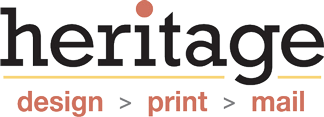Creative Design Trends: Making Direct Mail Stand Out

A unique approach always gets attention. Nowhere is the need for creativity stronger than in the crowded world of marketing. If you want your piece to stand out in the mailbox, it must be notable and memorable.
Today, it’s time to get creative. Let’s talk about direct mail creative design trends—it’s not all about flashy gimmicks but rather a well-thought-out, strategic, intentional design to create tactile, visual, and emotional engagement.
Why Format and Design Matter
Email fatigue is on the rise, meaning folks get too many emails in their inbox and often ignore and delete them, unopened and unread. Physical mail is once again (still) a powerful marketing channel.
But any marketing channel is only as good as the attention it commands. If a direct mail piece looks ordinary, people won’t hold onto it. The best way to stand out is to create something artful and impactful.
That notability begins with how a piece of direct mail is constructed. Emerging direct mail formats break the mold and offer new ways of grabbing your audience.
A few formats stand out:
- Offset folds and fold-over reveals let brands guide the recipient’s eye and build curiosity.
- Odd sizes feel premium and unexpected in a stack of standard mail.
- Layered textures, die-cuts, and dimensional designs create a tactile experience for recipients.
- Tech tools like QR codes and Augmented Reality incorporate well with direct mail pieces.
- Personalization is another way you can command the attention of your audience.
At Heritage, we’ve long advocated for this design-forward approach—especially because it’s backed by proven engagement results and positive outcomes.
The key to making attention-grabbing pieces is to dedicate enough space for the job. Create a reason for them to dig in, read deeper, and interact. The goal is to move away from the “glance and toss” with a CTA and creative design that encourages audience members to connect.
Design with Strategy, Not Just Style
It’s tempting to maximize your message by adding as much information as possible. However, cramming too much into one piece can cause your audience to skim and even overlook the mailing completely.
At Heritage, we suggest a more methodical approach. All direct mail should be designed with intention. Your branding should be evident on every piece. Expanding and getting creative is okay, but your design should still match your company tone in form, message, and audience. The goal is to support an even deeper level of brand engagement through storytelling.
Personalization plays a huge role in the strategy. When you’ve figured out exactly who your audience is, it becomes easier to visually and emotionally connect with them. Once again, this is where having clean, solid data goes a long way to supporting positive outcomes.
With tools like design-to-print flexibility, you can change-up names, content, and custom graphics based on data. Create a personalized, unique message that truly speaks to the concerns and pain points of the reader. With design-to-print, you get the best of both worlds: creativity and scalability.
Copy and layout should blend together and complement each other to reinforce the message, not to fight it. You can’t go with copy that’s merely personalized and expect it to be enough. You must design for the personalization—gender, interest, region. These demographics greatly inform the visual direction of a printed piece. You go beyond just having the right, catchy words.
2025 Design Trends to Watch
As we move through 2025 and into 2026, direct mail design continues to evolve. Many of these changes speak to consumer expectations, a focus on sustainability, and a strong desire for meaningful, tangible engagement. The most successful campaigns of the future will balance smart strategy with aesthetic creativity.
Minimalist, Intentional Layouts
Minimalism has been trending for a while and continues to dominate. It’s not exactly a design fad but rather a way to get your core message across in today’s attention economy. More brands are embracing:
- Bold, clean fonts and typography
- High-contrast layouts
- Spacious designs with plenty of room
Minimal layouts let your CTA shine and help make even the most complex messages feel digestible. When done well, minimalism creates a feeling of luxury and authority.
Sustainable & Ethical Design Choices
Consumer expectations shift, but eco-conscious design is still a necessary consideration.It’s often a significant factor to help capture a company’s overall philosophy and brand persona. Eco-friendly direct mail might include:
- Recycled or FSC-certified paper stocks
- Vegetable- or soy- based inks
- Compostable packaging
- Light-ink or monochrome designs to reduce material waste
Customers are interested in supporting brands that have good ethics and future-forward mindsets. Sustainability will likely continue to be the expectation throughout the industry.
Story-Driven Direct Mail
Story-driven pieces aren’t new, but there’s a strong trend toward embracing a bibliophile approach. Narrative-based mailers that include foldouts, reveal a sequence, or even in formats that mimic storybooks or personal letters get more engagement. Why?
- They feel personal and direct
- They encourage longer dwell time
- They build an emotional connection
- They stand out from “hard-sell” content
By structuring your next direct mail piece around a clear and compelling storyline, you’ll foster trust with your audience and make a memorable piece.
Enhanced Tactile Design
Tactile marketing is surging. Marketers recognize there’s a “touch factor” to direct mail that digital advertising can’t replicate. Tactile enhancements might include:
- Soft-touch or velvet coatings
- Embossing and debossing
- Layered paper stocks or vellum overlays
- Die-cut shapes or windows that invite interaction
Tactile design features look premium and beg for interaction. They extend the time a recipient holds (and reads) the piece.
Print-to-Digital Integration
With all the talk of direct mail and digital burnout, it’s still important to recognize that technology will keep growing and becoming even more seamless. To bridge the gap between print and digital, consider the following:
- Enhanced QR codes with trackable journeys
- NFC chips embedded in luxury mailers
- Augmented Reality elements that animate when scanned
These tools will likely continue to expand and grow. They offer real-time data and tracking (not to mention the fact that they position brands as innovative and forward-thinking).
Personalization Through Visual Identity
People have come to expect at least some level of personalization. As we move ahead, advanced personalization techniques will take us well beyond addressing customers by name. Some brands have started to tailor:
- Visual themes based on customer segments
- Color palettes that align with buyer persona data
- Localized content, such as regional imagery or slang
Yes, this level of personalization requires excellent data, but when executed well, it helps marketers create pieces that feel completely bespoke and individualized.
Dimensional and 3D Formats
Flat mailers are still the standard, but dimensional mailers will level up your approach. Elements like pop-up boxes or layered pieces create those memorable “wow” moments that make an outsized difference. These formats
- Are less likely to be discarded unopened
- Deliver a memorable unboxing experience
- Are ideal for high-value prospects and B2B accounts
While they can be costlier to create and mail, dimensional designs often get far better ROI when used alongside targeted campaigns.
Bottom line? In the future, the most effective direct mail campaigns will be those that combine clean design, creativity, storytelling, and data-driven personalization. Stay on target to stay ahead of the attention curve.
Heritage Can Help You Get Creative
We recently completed a major portfolio shoot featuring some of our most innovative work in action. We experimented with clever foldout formats and emotionally resonant messaging.
These weren’t just design exercises—they were high-performing campaigns rooted in client goals and real data. From nonprofit storytelling to high-tech B2B showcases, our team has pushed the envelope (literally and figuratively) with design that delivers.
Whether you’re working on a one-off campaign or an entire rebrand, we can help you conceptualize, create, and deploy designs that don’t just get noticed—but get results.
Want to see examples? Contact us to see what’s possible or schedule a strategy call with our experts to learn how creative design can boost your next campaign.
